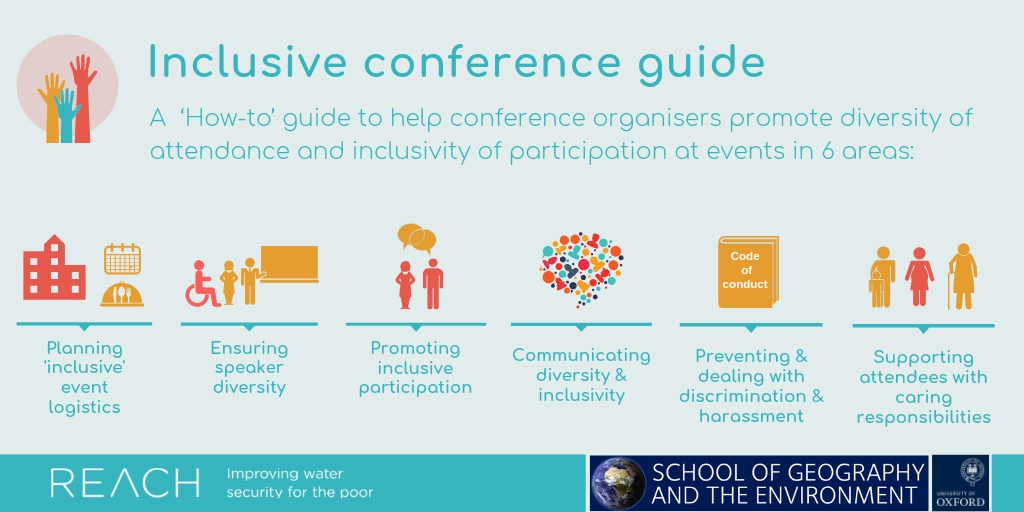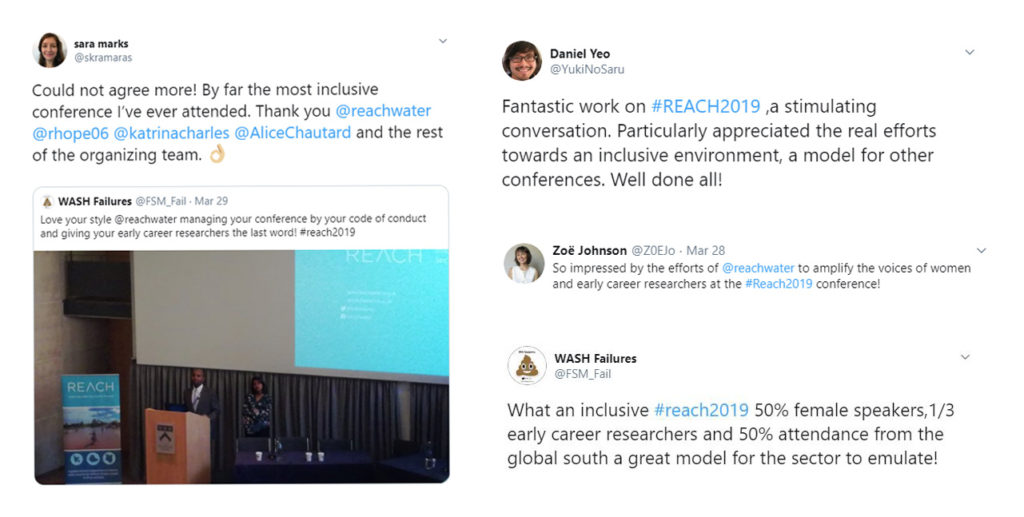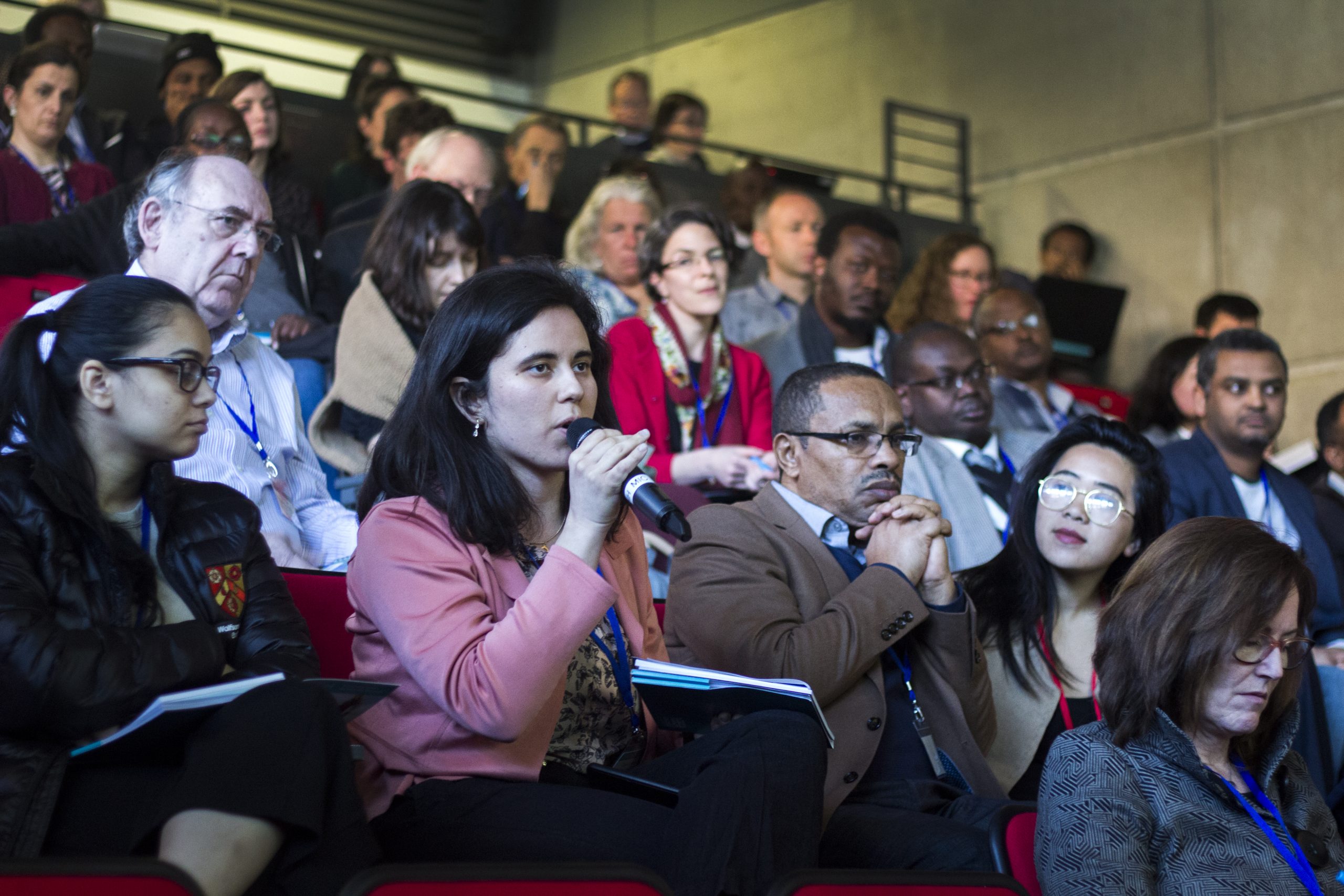Alice Chautard, University of Oxford
In this post, Alice Chautard reflects on how conferences, and events more generally, can be planned to ensure and promote diversity of attendance and inclusivity of participation. She presents 10 insights from the best practice guide to inclusive conferences she co-authored after implementing these inclusive planning principles at the annual REACH conference in March 2019.
Conferences provide scientists and professionals with the opportunity to disseminate their work, network, and form collaborative relationships for future work – they are thus important for career development. However, for institutions organising conferences, these events are often also an opportunity to demonstrate excellence and showcase cutting edge work by leading professionals or academics. As women and many minority groups are still underrepresented in academic and scientific professions, especially in leadership roles, this is often reflected in the speaker lineup and other aspects of the conference programme and logistics.
Guide to inclusive conferences: why and how?
In March 2019, we, at REACH, organised an International Conference on Water Security and Poverty. Well aware of the lack of inclusivity and diversity at many academic conferences, we wanted to do things differently. In the early stage planning of the conference, we spoke to conference organisers, gender experts and academics, and looked out for guidance to follow on developing inclusive conferences. Yet to our surprise, we found a limited amount of comprehensive resources available online – so we thought there might be value in creating our own ‘best-practice guide’.
Over the course of the past few months, Dr Claire Hann (Equality and Diversity Officer, School of Geography and the Environment) and myself have dived into the literature on inclusive conferences, spoke to experts and organized our own survey of more than 230 people working in academia, as well as the wider public, third and private sectors. Almost 85% of survey respondents agreed that it is important for conferences to have policies in places to promote greater diversity at conferences. However, less than one third of respondents (32%) felt that conferences they had attended had been organised in a way that promoted women’s participation and exposure.
The guide we are releasing today is wide-ranging in its coverage covering six areas of conference planning, that are presented in the infographic below.

Importantly, it was prepared to “encourage rather than prescribe,” and, we hope, will serve as an accessible step-by-step tool to assist organisers of events, large and small, in promoting diversity of attendance and inclusivity of participation.
What are 10 key takeaways for developing an inclusive conference?
- Many early decisions about conference planning can lock you in to an ‘un-inclusive conference.’ For instance, picking a venue that does not allow children on site, does not meet accessibility requirements, or is located in an ‘unsafe’ area; picking a date that overlaps with school or key religious and national holidays.
- There are specific barriers limiting a diversity of speakers at conferences (e.g. caring responsibilities), however we also all have implicit biases that are shaped by the society and culture in which we live and operate in. Recognizing and understanding both, is essential to developing an inclusive conference.
- Diversity should not solely focus on gender. Many minorities also experience challenges in being excluded or discriminated against at conferences on account of their ethnicity, religion, gender identification, seniority, physical abilities or other characteristics of their identity.
- Speaker diversity should span beyond panels. An inclusive conference should aim to spread diversity among all speaking or presenting roles (keynotes, session chairs, poster presentations, closing speech etc.)
- Choosing alternative formats can help create a more inclusive conference. The default format is often the keynote lecture or panel discussion in a large lecture theatre, with the aim of presenting cutting edge work from a researcher or professional. Recognising that conferences serve other important purposes – fostering collaborations, building skills, raising profiles and supporting career development – may justify the adoption of other types of formats that are more conducive to sharing knowledge, generating new ideas and building partnerships.
- Ensuring speaker diversity is important but not sufficient to developing an inclusive event. We recommend that conference organisers work to ensure everyone (speakers and attendees) has equal opportunities to participate in discussions, and actively engage in Q&As and networking opportunities.
- Conference communications, too, should be inclusive. For instance, this entails ensuring diversity in who is featured and how, in online and print communications, before, during and after the event.
- Caring responsibilities can be a considerable barrier to attending and presenting at conferences for both men and women – although the responsibility is often largely borne by women. While conferences can be designed to help, more funding for caring costs is also needed.
- Recognise that incidents of discrimination and harassment happen, and make your stance clear. For instance by specifying what is (un)acceptable behaviour (e.g. code of conduct) and making sure there is a clear process for reporting incidents.
- We believe inclusivity is an ambition that organisers can and should continuously work towards, always allowing room for learning and improvement. You won’t necessarily get everything right the first, second or third time around, but learning from mistakes and sharing ideas and best-practices is key to improvement.
Our experience organising an inclusive conference
We were delighted that many of the recommendations from the guide were successfully put into practice at our REACH conference. Half the speakers at the conference were women, half were from a Black and Minority Ethnic (BME) background and one third were early career researchers. We asked participants to sign a code of conduct and had a clear process for reporting incidents. All session chairs were asked to take a question from a woman or early career researcher first, which visibly changed the dynamic of the Q&A sessions, allowing a wider variety of views to be expressed in an open and receptive setting.
The result? We were pleased to hear several delegates mention it was the most inclusive they had ever been to. But most importantly, we felt that our efforts increased the visibility of many researchers, encouraged engagement and ideas sharing, energised our audience, provided a benchmark for future events, and, we hope, inspired others.

Looking ahead
Of course, inequality of opportunity within academia is not something conferences alone can tackle, but they are a good place to start because of their critical role for career development. In many ways, organisers can address these gaps by taking small steps – others obviously require more systemic thinking and changes, but it is not impossible.
The good news is that many conferences are now proactively trying to make conferences more inclusive. The guide been endorsed by the School of Geography and the Environment, and we hope will support and encourage many professionals within academia and beyond.
You can access the guide here. For any questions or comments, please email Alice Chautard: alice.chautard@ouce.ox.ac.uk

